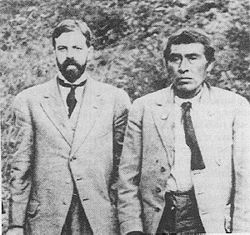Alfred L. Kroeber
Alfred Louis Kroeber ( born June 11, 1876 in Hoboken, New Jersey; died October 5, 1960 in Paris, France) was one of the most influential figures in United States anthropology in the first half of the twentieth century.
Life
Kroeber was born in Hoboken, New Jersey. He received his doctorate under Franz Boas at Columbia University in 1901, basing his dissertation on his field work among the Arapaho Indians. He spent most of his career in California, primarily at the University of California, Berkeley. The anthropology department's headquarters building at the University of California is known as Kroeber Hall.
Kroeber was father of the academic Karl Kroeber and the science fiction writer Ursula K. Le Guin by his second wife, Theodora. He also adopted the two children of Theodora's first marriage, Ted and historian Clifton Kroeber. Clifton and Karl recently (2003) edited a book together on the Ishi case, Ishi in Three Centuries. This is the first scholarly book on Ishi to contain essays by Indians.
Kroeber died 1960 in Paris, France from heart failure.
Work
Although being known primarily as a cultural anthropologist, Kroeber did significant work in archaeology, and he contributed to anthropology by making connections between archaeology and culture. He conducted excavations in New Mexico, Mexico, and Peru.
Kroeber and Roland Dixon were very influential in the genetic classification of Native American languages in North America, being responsible for groupings such as Penutian languages and Hokan languages.
He is noted for working with Ishi, who was claimed (though not uncontroversially) to be the last California Yahi Indian. His second wife, Theodora Kroeber, wrote a well-known biography of Ishi, Ishi in Two Worlds.
Kroeber and his students did important work collecting cultural data on western tribes of Native American Indians. The work done in preserving California tribes appeared in his Handbook of Indians of California from 1925. These efforts to preserve remaining data on these tribes has been termed "Salvage ethnography", the concept Kroeber developed with Robert Lowie. He is credited with developing the concepts of culture areas and cultural configuration (Cultural and Natural Areas of Native North America, 1939).
Legacy
His textbook, Anthropology (1923, 1948), was widely used for years.
His influence was so strong that many contemporaries adopted his style of beard and mustache as well as his views as a social scientist.
Bibliography
- Kroeber, Alfred. (1923). Anthropology
- Kroeber, Alfred. (1925). Handbook of the Indians of California
- Kroeber, Alfred. (1939). Cultural and Natural Areas of Native North America
- Kroeber, Alfred. (1944). Configurations of Culture Growth
- Kroeber, Alfred. (1952). The Nature of Culture
- Kroeber, Alfred. (1957). Style and Civilizations
External links
- Sex in Natural History (A. Kroeber talks at UC Berkeley, 1956). (Online audio recording)
- Bibliography
Credits
New World Encyclopedia writers and editors rewrote and completed the Wikipedia article in accordance with New World Encyclopedia standards. This article abides by terms of the Creative Commons CC-by-sa 3.0 License (CC-by-sa), which may be used and disseminated with proper attribution. Credit is due under the terms of this license that can reference both the New World Encyclopedia contributors and the selfless volunteer contributors of the Wikimedia Foundation. To cite this article click here for a list of acceptable citing formats.The history of earlier contributions by wikipedians is accessible to researchers here:
The history of this article since it was imported to New World Encyclopedia:
Note: Some restrictions may apply to use of individual images which are separately licensed.
